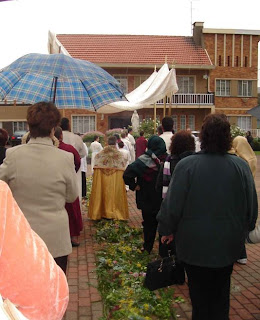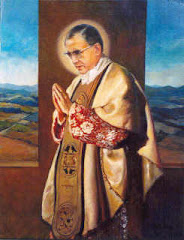I also continue, on a daily basis, to thank God for the presence and grace of His Holiness, Pope Benedict XVI, in our lives. It has been a very dark period with regard to my Faith, but also a time of great Light. This has been due, in a large part, to the gentle wisdom and guidance of our Holy Father. His words are always a true guide and inspiration in these times of continual upheaval, both personally and globally.
Some weeks ago I read the following from the Holy Father’s book, God is Near Us. I had come across this passage quite by coincidence, as I was flicking through the pages, but they would become even more relevant later, as I will explain:
One evening, during the following week, I had a rather unpleasant experience. An experience which I have had only once before. A feeling of being, internally, in total darkness. My previous experience had been nightmarish but, at that moment, I recalled what I had read the previous week and I felt a deep sense of comfort. A deep sense that that moment was a gift. It was only in that darkness that I could see the Light, that I could truly sense something of my own smallness but that I was nevertheless being held by an strong and incomprehensible Love, one that we can simply not match with our own efforts.“Even when Abraham was still on his way, and as yet knew nothing of the mystery of the ram, he was able to say to Isaac, with trust in his heart: Deus providebit – God will take care of us. Because he knew this God, therefore, even in the dark night of his incomprehension he knew that he is a loving God, therefore, even then, when he found he could understand nothing, he could put his trust in him and could know that the very one that seemed to be oppressing him truly loved him even then. Only in thus going onward, so that his heart was opened up, so that he entered the abyss of trust and, in the dark night of the uncomprehended God, dared keep company with him, did he thereby become capable of accepting the ram, of understanding the God who gives to us that we may give. This Abraham, in any case, has something to say to all of us. If we are only looking on from outside, if we only let God’s action wash over us from without and only insofar as it is directed toward us, then we will soon come to see God as a tyrant who plays about with the world. But the more we keep him company, the more we trust in him in the dark night of the uncomprehended God, the more we will become aware that the very God who seems to be tormenting us is the one who truly loves us, the one we can trust without reserve. The deeper we go down into the dark night of the uncomprehended God and trust in him, the more we will discover him and will find the love and the freedom that will carry us through any and every night. God gives that we may give. This is the essence of the Eucharistic Sacrifice, of the sacrifice of Jesus Christ; from the earliest times, the Roman Canon has expressed it thus: “De tuis donis ac datis offerimus tibi” – from your gifts and offerings we offer you.” (p.46-47)
“It is easier to love someone that you know, than to love someone you don’t know.” These particular words from Father Thomas’s Christmas Mass homily, with reference to our love of Christ, the need to make an effort to come to know Him and love Him more intimately, continue to resonate in my mind. It led me to reflect on my own lack of love for Our Lord. On how much easier it is to allow the distractions of the material world to overwhelm us and trick us into thinking that it alone can sustain us. I find that one sure source of coming to know Christ more intimately, is the through the words of the Holy Father. I found his meditation on the Liturgy of Hours during the opening of the 12th General Synod of Bishops to be particularly moving. The meditation as a whole, touched me deeply, as so many of his words of the Holy Father often do. However, during a rereading of this meditation this afternoon, these words moved me:
“Therefore, exegesis, the true reading of Holy Scripture, is not only a literary phenomenon, not only reading a text. It is the movement of my existence. It ismoving towards the Word of God in the human words. Only by conforming ourselves to the Mystery of God, to the Lord who is the Word, can we enter within the Word, can we truly find the Word of God in human words. Let us pray to the Lord that he may help us search the word, not only with our intellect but also with our entire existence.”I see in his own words, that movement towards God in human words. Strangely, these ‘words’ connect with something else that Father Thomas said regarding Scripture during his Christmas homily. He recounted how he often people tell him how wonderful a certain movie is. How, for example, they have seen it ten times. His response to this was to say how marvelous it would be if we were to devote this amount of enthusiasm to reading the Gospels. To read a passage from the Gospel ten times. How right he is! I myself am overtly fond of rewatching particular scenes from certain movies. It is only through that sort of immersion in Scripture that I will indeed be able to search the Word, with my entire existence.
May the Lord protect and sustain our Holy Father so that he might continue to be a light and guide for all of us within the encroaching darkness.













